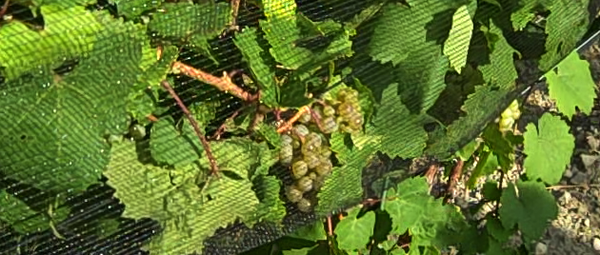
By Tom Mansell, Science Editor
In my last post, I mentioned bird netting and how exposed grapes need to be protected from birds, especially once they are ripe. Birds, like people, love to eat wine grapes. They also seem to have an uncanny ability to determine when grapes are ripe and, if left uncontrolled, decimate a vineyard's grape supply.
It got me thinking about several different methods that growers use to keep their yeast food from becoming bird food. A short sampling:
Shiny Objects
Occasionally in orchards, you will see pie plates and shiny mylar tape tied to a post, floating in the breeze. Sometimes you will also see large yellow balloons emblazoned with eye-shaped art.
Birds are very visual creatures and easily spooked, so one would think that these might scare birds away. Unfortunately, birds adapt to these devices pretty easily, and after a few days they will likely not be effective. Mylar tape has been used in blueberry orchards but has been found to be ineffective against bird damage in large fields, and so is likely not to work too well in the vineyard.
Scarecrows
Anyone who's seen birds sitting on a scarecrow knows approximately how effective they are. Again, the birds seem to quickly adapt to the absence of a real threat. Recent advances in scarecrow technology, however, can improve their effectiveness. The Scarey Man [sic] is an inflatable scarecrow that can be triggered along with other disturbances at random intervals to avoid adaptation.Netting
Netting is very commonly used to prevent bird access to grapes. Work done at the Cornell Cooperative Extension on Long Island has studied different types of bird netting and found that finer mesh netting is most effective against birds. Side netting (netting that only covers the fruiting zone) can allow for continued hedging (trimming the tops of the canopies) after bird nets are applied.
Another important parameter of the effectiveness of netting is how securely the nets are tied on. If there is a big gap in the side, it doesn't matter how fine your mesh is, they'll get in. Birds are crafty like that.
A downside to netting is, well, the fact that you have to buy it and put it up. The work estimates that netting can cost up to $1500/acre, and estimates are about $300/acre for labor to put it up and tie it securely. Still, especially for areas like Long Island, netting is a necessity, as hungry birds commonly damage a large amount of crop.
Squawk Boxes
Devices like BirdGard can play digitally recorded bird distress sounds and the calls of predatory birds to frighten birds. I've definitely heard this used in vineyards and if you don't know that there is bird control in place, you might get a little freaked out.Cannons
This one could be the most fun way to scare birds away, but also the most problematic to neighbors. A propane-powered explosion can register up to 130 decibels (louder than a rock concert). Sounds like this are ubiquitous around harvest time, but again, absent the threat of real danger, birds adjust to these diversions.Chemicals
Methyl anthranilate can be used to control birds. If the name of this chemical sounds familiar, it's because it is one of the components of "foxy" aroma in labrusca-type grapes like Concord, Catawba and many table grapes.This makes me wonder if these grapes suffer less from bird depredation than others. Hmm… my guess is that methyl anthranilate works because it is (coincidentally) also secreted by some weasels, natural bird predators.
Falconry
Finally, the most bad-ass way that I have seen of controlling birds in the vineyard has got to be the medieval lost art of falconry. Accrording to a story from NPR, a California winegrower has turned to training actual bird predators to rid his vineyard of starlings.
Growers: What interesting methods to YOU use to protect your crop from birds?
Much of the information for this piece was drawn from the work of Dr. Paul Curtis of the Cornell Department of Natural Resources and Alice Wise or Cornell Cooperative Extension in Long Island. Thanks to Hans-Walter Peterson for helpful discussions.
